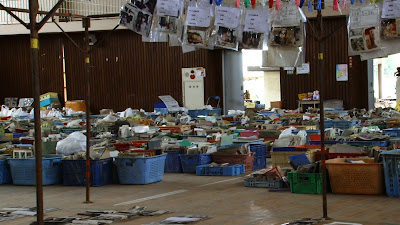→Japanese
Visit to the Taro district in Miyako after staying in Hachinohe, on the 20.05.11 (Friday)
We visited Taro again after Hachinohe. We returned to the same place that we had visited in April.
<Route>
Morioka -> Hachinohe -> Miyako (Taro) -> Tono -> Kitakami
 *** Visit to Hachinohe ***
< Situation of the fishery harbors of Hachinohe and Misawa >
*** Visit to Hachinohe ***
< Situation of the fishery harbors of Hachinohe and Misawa >
• Reminders of the tsunamis can be still seen in many areas on the coast, but in others the situation looks much better than it did one month ago.
• At several pensions, factories, and small houses, one can see traces of the flood. The interiors are now almost empty.
• Some people who lived there have helped rebuilding process. Otherwise, only few other people were in the fishery harbor.
• The cleaned up debris had covered up a nearby hill.
We met a man there who was able to tell us how things had been both before and after the tsunami:
• Before the tsunami there had been buildings where now only huge sand fields remained.
• There are some people who now must live in shelters or temporary housing. Their houses had been destroyed by the earthquake and tsunami.
• Some people looked through the debris for valuables, goods, or materials that could still be used.
*** Visit at the villages of Noda and Tanohata and the Taro district of Miyako ***
We visited the villages Noda and Tanohata and the Taro district of Miyako. These places lie between Hachinohe and Miyako. One and a half months have already passed since the last time we were here.
< The situation in the Noda and Tanohata villages and Taro district of Miyako>
We spoke with a worker from one of the volunteer centers.
• The debris, houses, and buildings that were destroyed had already been cleared away by construction vehicles.
• Several large areas have been cleaned and organized very smoothly.
* In the beginning of April, there was a lot of debris. At that time, the Japanese self defense force (SDF) and the American military aided in looking for missing people and corpses.
<The temporary shelter area in Green Pia Taro>
There is a temporary shelter located in Green Pia Taro which is located in the Taro district of Miyako. There are still many victims of the catastrophe living here.
We did an interview with a person responsible for the organization in Green Pia Taro who was a native of the area.
• Many the victims of the catastrophe from the Taro district are living here as it serves as a temporary shelter or as a transition hostel.
• At present, approximately 600 people live there.
They use the gymnasium, the hotel, and temporary housing units that have been recently built there.
• The gymnasium of Green Pia Taro is sufficiently big to hold a large amount of people. There are neatly built dividers in the gymnasium.
• In the hotel area of Green Pia Taro is where the injured, sick, and pregnant people live.
•In the area around Green Pia Taro temporary housings were built as transition apartments.
The victims have started slowly moving into the temporary housing.
• For the victims of the catastrophe located in Taro, Miyako, temporary housing was being built until end of June.
• All the people from this district were evacuated into this temporary housing.
Therefore, the neighborhood-like relationships remain intact here. For this reason, the victims could start cooking meals for all the evacuated victims and to organize their time in the most efficient way. So, there is an example of “oshibana kyoushitsu” in this temporary housing area.
• There are sufficient volunteers in Green Pia Taro. In this area, only natives from the area serve as volunteers.
• Voluntary events are welcome in Green Pia Taro. Those who wish to do them can announce their plan directly to the administration in Green Pia Taro.
• It is possible to visit people in the temporary housing until 20:30. After this time the area is restricted to the residents only.
<Problems in the future>
• If the victims move in to temporary housing, they will have less contact with others than they did in the gymnasium. Therefore, the condition of the victims must be controlled regularly.
• If the victims move in to temporary housing, they are no longer provided support goods. However, in the surroundings areas of the temporary housing, there are not any stores at present because they were destroyed by the tsunami.
Victims with a car would therefore have to drive to do their shopping. However, most of the catastrophe victims don't have any means of transportation.
Translated by Akiko Tada /Robert Staehlin / Yuko Sakajiri
















